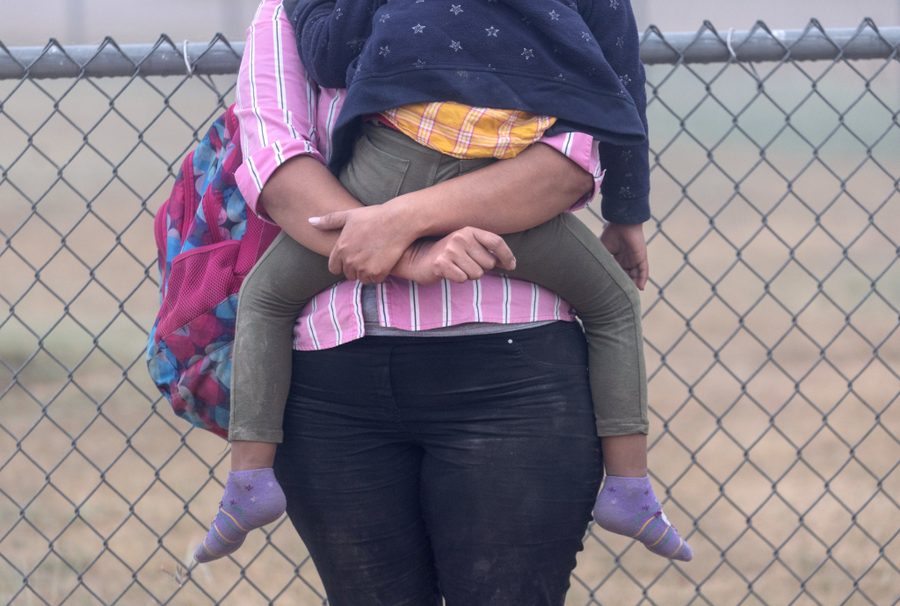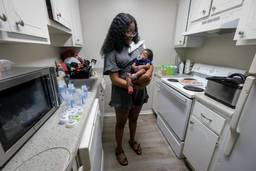The Latest Argument Against Abortion Rights: It's Not Hard to Be a Working Mom
Experts and working moms blast the absurdity of this key argument being used to take down abortion rights.
Bryce Covert

The Supreme Court recently heard oral arguments in a case that may very well overturn Roe v. Wade. The case, Dobbs v. Jackson Women’s Health Organization, is over a Mississippi law that bans abortion after 15 weeks after a woman’s last period, running afoul of current Supreme Court precedent. In defending the law and the potential to make abortion illegal in the United States, Mississippi Attorney General Lynn Fitch made a novel argument: that abortion rights are no longer necessary because it has become so easy to raise a child while working outside the home. This claim directly challenges the logic of previous rulings: In its 1973 decision in Roe, the Supreme Court said that an unwanted pregnancy “may force upon the woman a distressful life and future,” while Planned Parenthood of Southeastern Pennsylvania v. Casey, a 1992 case that narrowed abortion rights but upheld Roe, said abortion rights are necessary “for women to participate equally in the economic and social life of the Nation.”
But in a brief she co-authored in July, Fitch argued against Casey’s conclusion, stating that after Roe was decided there were many laws enacted to “protect equal opportunity — including prohibitions on sex and pregnancy discrimination in employment, guarantees of employment leave for pregnancy and birth, and support to offset the costs of childcare for working mothers.” She added, “Sweeping policy advances now promote women’s full pursuit of both career and family.”
“A lot has changed in five decades,” Fitch said in a statement. “In these last 50 years, women have carved their own way to achieving a better balance for success in their professional and personal lives.” While Mississippi’s lawyers made other arguments — for example, that states should have the authority to regulate abortion as they see fit — the economic claims seemed persuasive to at least one justice, Amy Coney Barrett, who also suggested that the ability to put a baby up for adoption also negates the “burdens of parenting.” The country will find out how this argument landed with the full court when it releases its decision in the case next summer.
But experts argue the idea that it’s no longer a challenge to combine motherhood and working for pay is in contradiction of all available evidence. “It’s totally absurd,” said Betsey Stevenson, an economist at the University of Michigan. “The idea that abortion has served its role because there’s no longer tradeoffs is bogus.” Many of the policies and protections Fitch named are only available in some places, and often to only an elite subset of workers. On the whole, it is still an enormous struggle to balance paid work with child rearing in the United States.
Jessica Rapp is just one example of how difficult those tradeoffs can be, even for someone with an advanced degree, flexible working options, and a decent salary. She had always worked full-time after graduate school — that is, until she gave birth to her son. In truth, Rapp was working more than full-time before he was born: She worked five days a week going to people’s homes as a pediatric occupational therapist, and then in her spare time started an online business educating parents about child development and parenting.
But Rapp’s job allowed her to go part-time, so she and her husband “just assumed that he would keep working full-time” after taking his six weeks of paid leave, she said, and that she would reduce her hours to spend time at home with their young child. She felt lucky to have the option.
The challenges, however, started right after she gave birth. Rapp didn’t get any paid leave, so she took 12 weeks off without pay. “We didn’t account for how challenging finances would be,” she said, especially when they were hit with a $5,000 bill for the birth despite having health insurance. “The strain of that, mixed with unpaid maternity leave, put us in the hole from the beginning financially.”
It meant focusing on paying the mortgage and hospital bills and more or less reducing everything else. They even had to go on a payment plan to pay off the hospital bill for her son’s birth. “We’re still paying it off and my son is 15 months,” she said. They haven’t been able to fly to Baltimore to visit her husband’s family as much as they wanted to, and there is family in California and Washington, D.C. who have never met their son.
So when it came time for Rapp to return to work, the cost of childcare was daunting — nearly impossible. The price was more than she made at her job. For the first seven months of her son’s life, her mother watched him twice a week so Rapp could work. “That literally saved us,” she said. “I don’t think we would have been able to survive without that free care.” But when her son became more mobile, it got to be too hard for her mother, so they put her son in daycare twice a week. It costs $1,200 a month; Rapp’s parents are helping cover the cost because she and her husband can’t afford it on their own. They were again lucky in some ways, though: The first center they contacted put them on a waitlist and never gave them a spot, and the second center said it didn’t have part-time spots but then found a way to give them a space.
Rapp wanted to breastfeed her son, and for a while she was able to make it work. But when she went back to her job, because it involves traveling to clients’ homes, she had to pump breast milk in her car while driving between appointments. It was “really stressful,” she said. By month eight she decided to wean her son and switch exclusively to formula.
“It’s not been as easy as I would have thought, at all,” she said. In fact, she thinks being a working mother is more challenging than for previous generations of women. She noted that the cost of childcare has risen faster than inflation, and family and friends are less likely or able to help out, especially as family tends to live far away. “I think it’s gotten harder,” she said.
There are certainly some things that have improved. It’s true that more employers are offering paid family leave to their employees than when Roe was first decided. And yet less than a quarter of private-sector workers currently get the benefit through work, and it’s concentrated among the highest-paid workers. Just 12 percent of Americans earning in the bottom quartile of the wage distribution — those making about $15 an hour or less — get paid family leave. Even unpaid Family and Medical Leave Act protections that mean someone can’t be fired for taking time off to have a child only apply to about half the workforce; a woman who isn’t eligible “is not even going to be allowed by law to take the day off that she’s giving birth without losing her job,” Stevenson pointed out.
The United States also doesn’t guarantee paid sick leave, leaving around a quarter of private-sector workers without the ability to take paid time off if their children get sick. Once again, that benefit is far more likely for the highest earners who make over $30 an hour — over 90 percent get it — than the lowest ones. Just a third of those earning in the lowest 10 percent of wages, or less than $12 an hour, get paid sick leave. The highest-paid white-collar workers are also more likely to have control over their schedules and to have access to flexible working arrangements.
“For [Supreme Court Justice] Amy Coney Barrett, people in her category, I think it is easier,” said Nancy Folbre, an economist at the University of Massachusetts Amherst. White-collar women workers have more bargaining power, and they have used it over recent decades to demand workplace policies that better support raising children. “I don’t know how anyone could argue that it’s become easier for workers without a college education, mothers without a college education to combine paid work and mothering.”
Even at the top, however, things are still often challenging. While the Pregnancy Discrimination Act prohibits workplace discrimination on the basis of pregnancy, childbirth, or related medical conditions, many pregnant workers are still penalized for needs like time off for doctor appointments or even a stool to sit on while at work. There’s still a strong motherhood penalty in wages. Many high-paying jobs demand long hours, making it hard to leave for bedtime or a parent-teacher conference. That “rat race effect,” Folbre said, “does really hurt women.”
And when it comes to childcare, “If anything it’s gotten harder over time, because it’s gotten more expensive,” Stevenson said. Amy Coney Barrett, a mother of seven, benefitted from 16 years of “consistent childcare in the home” from her husband’s aunt, and Lynn Fitch, a single mother of three, had the means to afford both a nanny and daycare. But those are atypical situations. The hourly cost of childcare has risen rapidly, jumping 32 percent between 1990 and 2010 while American wages stagnated. The rising costs have depressed employment for working mothers with young children by 13 percent. Some cities and states have instituted free preschool for children ages three and four, but they’re outliers; across the 44 states (and Washington, D.C.) that actually fund preschool programs, only about a third of four-year-olds and just 6 percent of three-year-olds are enrolled.
Even a family that can afford the cost of childcare might not be able to find it. About half of American families live in childcare deserts where there are more than three young children for every licensed child care slot or no spots at all.
If there really had been an enormous improvement in women’s ability to work and raise children, “you would think that you would see increases in the labor force participation of mothers,” Folbre said. Instead, “Women’s movement into paid employment has kind of stalled for the last 20 years.” Women’s labor force participation hit a peak in April 2000 and has been declining since.
That hasn’t been the case in other developed countries that have done more to support working parents. The United States used to be at the top of the rankings for our share of working women compared to our peers; we’ve now fallen thanks to a lack of paid family leave, flexible work policies, and childcare spending.
It’s also important to keep in mind, Stevenson noted, that the gains that women have made in entering careers, rising through the ranks, and closing the gender wage gap started with, and are thanks to, their ability to control their fertility. Research has found that the legalization of abortion “increased women’s education, labor force participation, occupational prestige, and earnings,” in the words of two economists. Access to contraception to prevent unwanted pregnancies, and to abortion so pregnancies don’t have to be carried to term, allowed women to invest in their educations and their careers without the fear of being permanently interrupted. “Imagine taking out all the loans to go to law school, and you’re one year in and you have to drop out because you’re pregnant,” Stevenson said. Women who seek an abortion but aren’t able to obtain one are much more likely to fall into poverty and joblessness.
Because women have been able to delay motherhood, they’ve also been able to have children when more established in their careers, putting them in a better position when the motherhood penalty hits. “The rate at which you get promotions and raises goes down after you have children,” Stevenson said. “The farther you’ve climbed the ladder before you start to have that slowdown, the higher you’re going to be on that ladder for the rest of your life.”
In the years since Roe, job polarization and wage inequality have meant that the gains to be had from completing a college education are more important than ever. “What you would lose out on if you were unable to complete your college degree is greater today than it would have been 30 years ago,” Stevenson said. “I don’t think there’s any reason to think that our times are so different than we wouldn’t see the reverse” of women’s economic gains if abortion were once again illegal.
Especially as things are, for now, getting worse. The pandemic has decimated the childcare sector, with a third of providers shutting their doors and more than half reporting that they’re losing money. Millions of women left paid employment after their children were thrown out of daycares and schools — in November, there were 1.3 million fewer women in the labor force compared to 2019 — and things are nowhere near back to normal.
The Build Back Better legislative package that Democrats are trying to pass through Congress could improve things for working parents: It would offer them more subsidies to afford childcare and universal, free preschool, and the version passed by the House includes four weeks of paid family leave. But its future is uncertain, and even such provisions would still leave the United States behind many other developed countries. Nearly three-quarters of developed nations, for example, guarantee six months of paid parental leave for mothers.
“Are things different than they were in the ‘70s? Yes,” Stevenson said. She noted that it used to be legal to fire a woman for getting married or becoming pregnant; that’s now illegal. “But I wouldn’t say that they’re much easier than they were, say, 30 years ago.”
It’s taken having her son, and having her career pared back, to make Rapp realize she’s actually “very career-oriented,” she said. “When it’s taken away from you, you think about it more.”
Rapp loves being an entrepreneur, and while she enjoys her job, she’s ready to do something new. She dreams of growing her own business such that she could do it full-time. “I try to work on my business when [my son is] napping, which is not enough time,” she said. She has a long list of ideas for how to grow it, ideas she can’t get to because she doesn’t have the time. “I know, hands down, if I didn’t have a child I would be way father ahead in it,” she said. “It’s so hard… I’m passionate about that but I also want to be a good mom.”
She and her husband just don’t have the money to pay to put her son in daycare full-time. Full-time care would cost $2,200 a month, more than their mortgage payment. “We’re already so in the hole financially that we can’t even swing it,” she said.
She notes that her husband is great and helpful. Still, “The man’s job just for some reason just takes precedent, so the woman is often the one who has to sacrifice more career-wise,” she said. “I feel like I have to stay home with him more and take care of him.”
Bryce Covert is an independent journalist writing about the economy. She is a contributing writer at The Nation, and her writing has appeared in the New York Times, New York Magazine, Bloomberg Businessweek, The Atlantic, Time Magazine, Wired, the New Republic and others. She is a 2025 National Fellow at the USC Annenberg Center for Health Journalism and a 2025 recipient of the McGraw Fellowship for Business Journalism, and she was a Reporter in Residence at the Omidyar Network in 2023.







